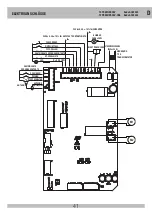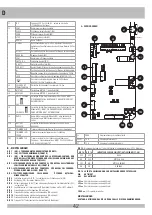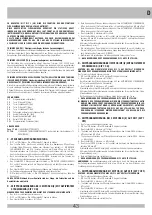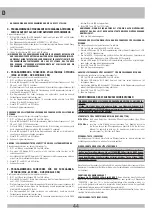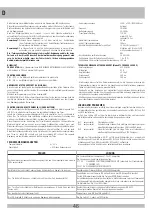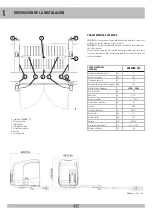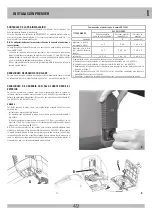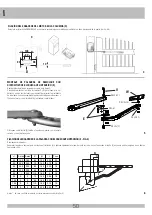
35
DIP 16 ON and DIP 4 OFF =>
if photocells are engaged during opening, the gate stops
and the gate only closes one second after the photocells
are disengaged.
DIP 16 ON and DIP 4 ON =>
if photocells are engaged during opening, the gate continues
to open. Upon disengagement of the photocells, the gate
stops and reverses closing motion after a one second pause.
If total opening is reached (end of opening time), immediate closing is deactivated
and automatic time closing is activated (if TCA trimmer is activated and LED DL6
is on). If during closing there is a rapid movement (e.g. pedestrian) the gate will
open again for two seconds and then close once again.
DIP 16 OFF =>
immediate closing after movement in front of the photocells is deactivated.
N.B.:
Please check photocell operation at least every six months.
EDGE (SAFETY STRIP) (COM-EDGE)
If engaged during opening, reverses the motion when closing.
If engaged when closing, reverses the motion when opening.
If it remains engaged again, it performs a further reversal after 2 seconds, then performs an
additional short reversal and then gives the sensor failure or engaged alarm (N.O. contact).
If the sensor remains engaged (N.O. contact) no movement is allowed.
If not used, jump the terminals COM-EDGE.
MONITORING OF SAFETY SENSORS (A+ TEST A-)
Sensors can be monitored through the A+ TEST input and DIP 12 ON.
The monitoring consists of a functional test of the sensor run after every full gate opening.
Closing the gate is therefore permitted only if the sensors have passed the functional test
after each opening.
CAUTION:
MONITORING OF THE SENSOR INPUT CAN BE ACTIVATED WITH DIP 12 ON OR
DEACTIVATED WITH DIP 12 OFF. IN FACT, THE FUNCTIONAL TESTING OF SENSORS IS
‘POSSIBLE ONLY IF THESE DEVICES HAVE THEIR OWN POWER SUPPLY.
A MECHANICAL SENSOR CAN NOT BE MONITORED, SO DIP 12 SHOULD BE SET TO OFF.
SENSOR AUTOTEST ALARM (DIP 12 ON)
If the sensor fails the monitoring test after opening, an alarm is displayed by the blinker
lighting up. Gate closure is not allowed in this condition. Normal operation can be restored
only by repairing the sensor and pressing one of the activated controls.
STOP BUTTON (COM-STOP)
The STOP button stops the gate during any operation.
If held when the gate is fully open (or partially when using the pedestrian control) automatic
closing is temporarily deactivated (if activated by the TCA trimmer and LED DL6 on). It is
therefore necessary to use a new command to make it close.
The automatic closing function is reactivated on the next cycle (if activated by the TCA
trimmer and LED DL6 on).
POWER SENSOR ALARM
The T2 PREMIER 24V control panel has automatic sensors that make the movement of the
gate reverse in case of impact against objects or persons in accordance with the current
EN standards (always use the right tool to ensure compliance with the values imposed by
the standard), without special adjustments on the control panel, as it operates using special
internal software. If the power sensor is used in opening or closing (only in high-speed) and
then again, in the opposite direction, the gate stops and then reverses for 1 second.
The alarm status will be displayed by the blinker which will remain active for one minute,
during which time you can restore gate operation by pressing any command button.
FUNCTIONING IN DEAD MAN MODE WHEN THE SAFETY DEVICES ARE FAILING
If the safety edge fails or remains engaged for more than 5 seconds, or if photocell fails
or remain engaded for more than 60 seconds, the open, close, k button and pedestrian
commands will work only in dead man mode.
The signal that this mode has been activated is given by the blinking of the programming led.
With the blinking of the programming led, the opening and closing operation are allowed
only with the command button pressed and held. The radio commands and that of automatic
closing, will be excluded, since their use in this mode, is not allowed by the norms.
Once the failing safety device is repaired, in automatic after 1 second, all standard
commands that were selected, such as step by step, automatic mode, radio commands and
automatic closing start functioning again.
Note 1:
during this functioning in dead man mode, in case of damage to the safety strips
(or photocells) the photocells (or safety strips) still work by interrupting the operation
in progress.
Note 2:
the stop command is not to be considered a safety command that can be bypassed
in this mode. Therefore, when pressed or damaged, it will not allow any movement
of the gate.
The dead-man operation is only an emergency operation which must be activated
for a very short period and with the complete installation at sight so to have a
secure and safe control of the system. As soon as possible however, the failing
safety devices must be repaired and activated.
BLINKER
N.B.:
This control panel can power ONLY BLINKERS ON A (ACG7061) CIRCUIT with lamps
up to 24V and 20W.
PRE-BLINKING
DIP 5 - OFF => the motor and blinker begin simultaneously.
DIP 5 - ON => the blinker begins 3 seconds before the motor.
GATE OPEN WARNING LIGHT (COM-SIGNAL)
Signals when the gate is open, partially open or not closed completely. Turns off only when
the gate is completely closed. This signal is active during programming.
N.B.:
Max 3 W. If
push buttons or lamps are in excess, the control panel processes will be endangered and
possibly halt operation.
OPERATION AFTER A BLACK-OUT (WITHOUT BATTERIES)
When the power supply comes back the DL1 led turns on and remains on for all the time
the gate stays open. The led will turn off only once the gate is completely closed. It is
recommended to fully open the gate. Let the gate close by itself or with automatic closing,
or wait until the blinker stops flashing before commanding it to close.
This will allow the gate to realign. If, motors were released and moved from the normal
position when closed during the blackout, the first movement after power returns must be
complete.
If the black out occurs when the gate is still moving or when the gate is open and the first
command sent after the black out is a closing command, the closing of the gate will be
carried out with a total delay between the two gate leaves. Therefore, first the leaf M2 will
close completely; once it is off, M1 will start closing. This separate movement of the two
gate leaves is done to avoid their incorrect overlapping.
TECHNICAL SPECIFICATIONS
- Temperature range
0 ÷ 55 °C
- Humidity
<95 % without condensation
- Voltage
230 V~ ± 10% (120 V 60 Hz upon request)
- Frequency
50/60 Hz
- Battery power
20-24 Vdc
- Transformer Power
130VA - primary 230 Vac - secondary 18 Vac
- Maximum absorption
50 mA
- Network Micro-switches
100ms
- Maximum power gate open indicator 24 Vdc 3 W (equivalent to one 3 W or 5 LED light
bulb with resistor in series at 2,2 K
Ω
)
- Maximum blinker power
24 Vdc 20 W
- Power available for photocells and accessories 1A ± 15%
- Power available for radio connector 200 mA
RADIO SPECIFICATIONS (model T2 PREMIER 24V-CRX)
- Receiving Frequency
433,92 MHz
- Impedance
52
Ω
- Sensitivity
>2,24 µV
- Pick-up time
300 ms
- Drop time
300 ms
- All inputs must be used as clean contacts because the power is generated internally
(secure power) to the board and is set up to ensure compliance with double or reinforced
insulation with regard to dangerous voltage.
- Any external circuits connected to the outputs of the control panel must be made in such
a manner as to ensure compliance with double or reinforced insulation with regard to
dangerous voltage.
- All inputs are controlled by a programmed integrated circuit that performs a self check
every time it starts operating.
TROUBLE SHOOTING
After having carried out all connections, by carefully following the layout and having
positioned the gate in intermediate position, check the correct ignition of red LEDS DL7,
DL8 and DL9
In case of no ignition of the LEDS, always with gate in intermediate position, check the
following and replace any faulty components.
DL7 switched OFF Faulty photocells
DL8 switched OFF
Faulty safety edge (In case the edge is not connected, carry out
jumper between COM and EDGE)
DL9 switched OFF
Stop button malfunction (if Stop is not connected, perform the jump
between COM and STOP).
During functioning with personnel present, with DIP 1 at ON, check that during opening of
M1 and M2 the green DL2 and DL4 LEDS switch on and that during closing of M1 and M2
the red DL3 and DL5 LEDS switch on.
Or else, reverse the wires of the motor.
G
B





















